A few weeks ago I went to Long Beach to hang out with one of my history homies, Jesse Lopez who runs the Hey Long Beach YouTube channel. Jesse took me on a little tour of some of the hidden history that can be found around Long Beach…if you know where to look.
Our 1st stop was Harvey Milk Park, which contains an incredible mosaic mural called “Recreation in Long Beach” that was created as part of the Works Progress Administration during The Great Depression. The mural hasn’t always been here though, it actually used to be somewhere else.

The original location of the mural was at the Long Beach Municipal Auditorium that was built in 1932 at a cost of $ 1.5 million and was located where the Long Beach Sports Arena now sits.
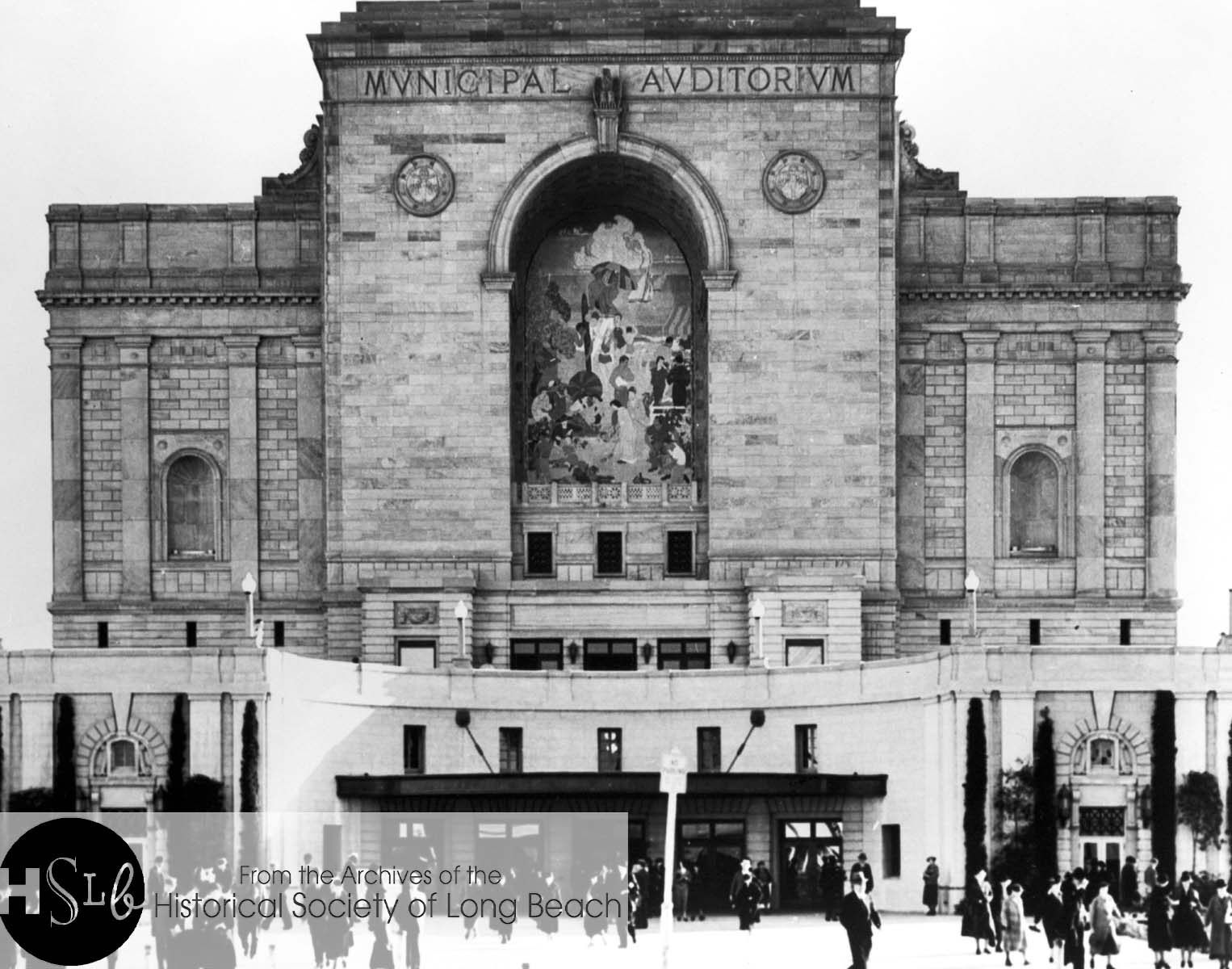
Photo Credit: The Historical Society of Long Beach
In 1936 the city applied for financing from the Works Progress Administration, or WPA for short, to add a mural in the niche of the front façade of the auditorium. The WPA was an agency created during the Great Depression to employ millions of jobseekers to complete public works projects, like constructions of public roads and buildings, but also public works of art.
The mural was originally designed by Henry A. Nord as a painted mural but was transformed into a mosaic by Stanton McDonald and Albert H. King. Over 40 artists worked more than a year to lay down the 466,000 tiles that brought Nord’s illustration of recreational activities in Long Beach to life. When it was completed in 1938, it was the largest cut-tile mosaic in the country, measuring in at 38 feet high and 33 feet wide, it was the crown jewel of the Long Beach Municipal Auditorium.
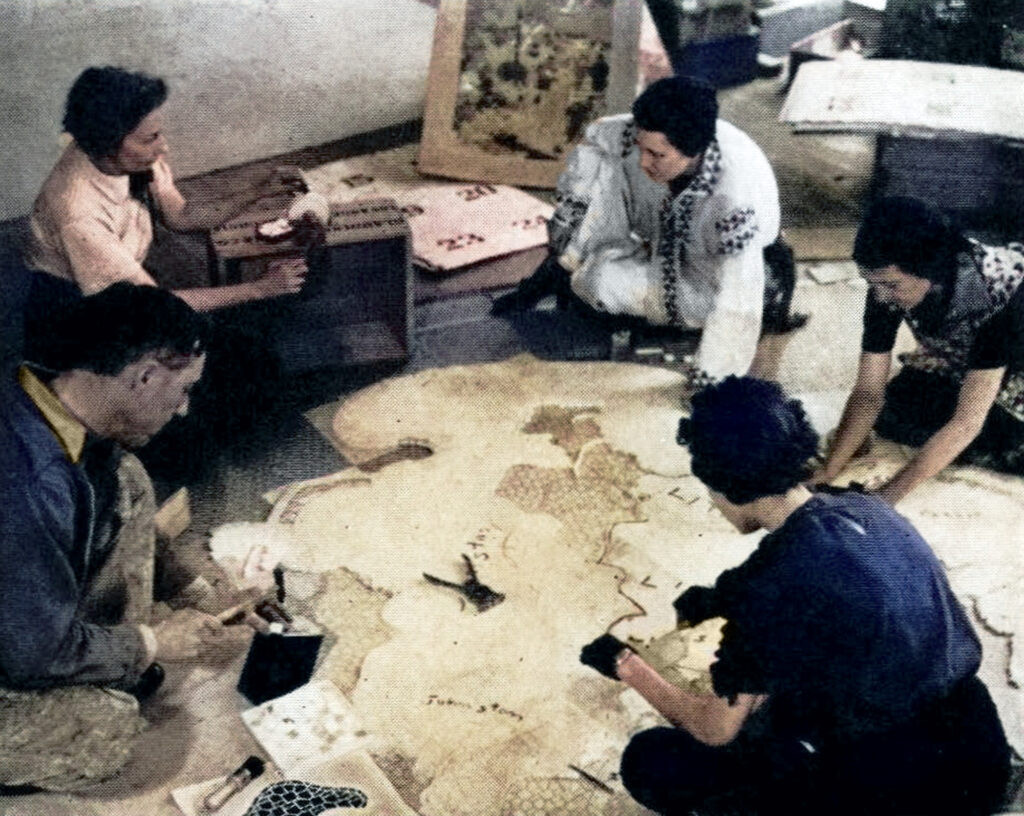
Despite only having stood for just over 40 years and hosting artists like Liberace, Judy Garland, and Elvis Presley, the Auditorium was demolished in 1975 to make way for the Long Beach Terrace Theater. However, thanks to community outcry, the mural was removed and placed in storage until it found a new home on the wall outside of the Long Beach Plaza parking structure, where it still stands today.

Having the mural in its new location in Harvey Milk Park allows us to better appreciate the artistry that went into its creation. You can see the cut tiles and the different ways that they were cut. Some of them were cut like little triangles, some of them were cut like little squares to indicate water, or grass, or any sort of texture. You can also see the names of the artists that worked on it along the sides of the mural.

This Mural not only helps to keep the memory of the Long Beach Auditorium alive but also shows what can be accomplished when the community bands together in the name of preservation.
Our 2nd stop was the courtyard of the Westin Hotel on Ocean Blvd which contains a giant statue called “Venus” that is one of the last remaining artifacts of a movie theater that once stood in that spot–The Fox West Coast Theatre.

The Fox West Coast Theatre was built in 1925 and opened as the “West Coast Theater,” it was the largest of the palace movie houses in Long Beach. It could seat up to 2,200 people and had a Wurlitzer pipe organ. The theater was eventually renamed the Fox West Coast Theater after it was acquired by William Fox in 1929.
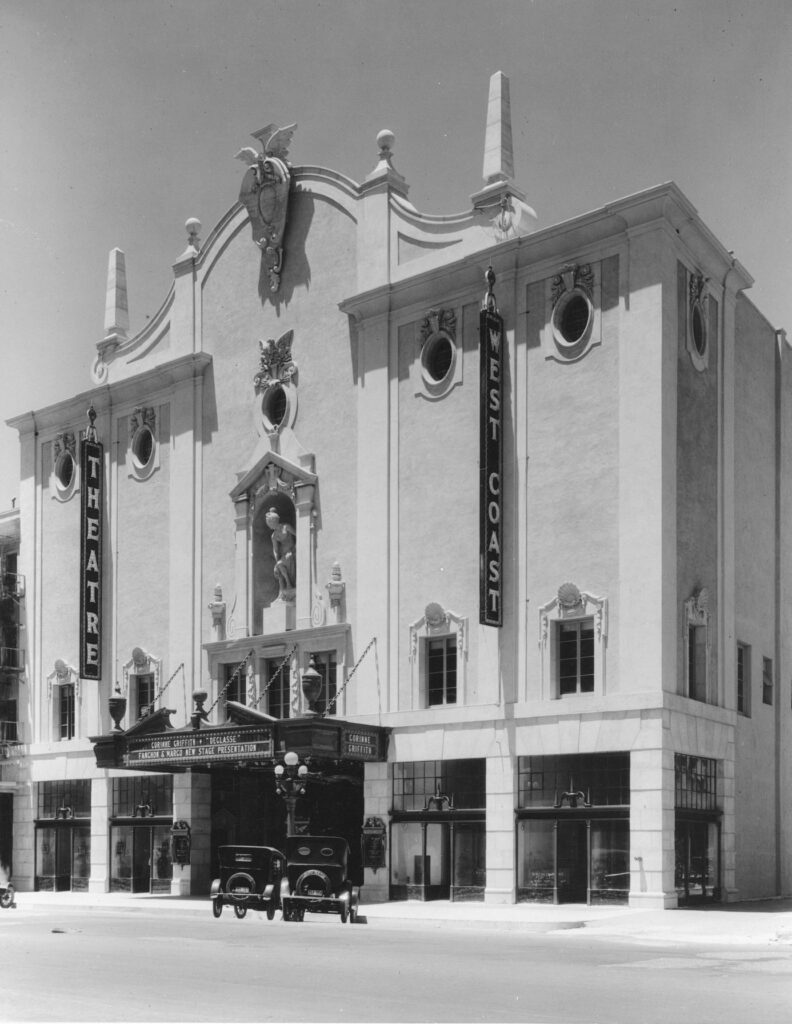
Photo Credit: UCLA Library
Over the ensuing decades, the theater changed ownership and uses multiple times. It was closed as a regular movie Theater in 1974, then used as a rock music venue, then a church and finally a Spanish language movie theater.
In 1985, just prior to its demolition, it got a proper farewell party that included an organ prologue, a screening of “Footlight Parade,” and the Hearst Newsreel of “The Long Beach Earthquake of 1933.”

The building was demolished in 1987 to make way for the Westin Hotel. However, not everything was destroyed, the statue that once sat above the marquee was rescued and placed in the public courtyard of the Westin and was renamed “Venus” and rededicated in 1989. Also, the lobby doors of the theatre were also saved and are now on display at the Historical Society of Long Beach.
While the Westin Hotel now stands where the Fox Theatre once stood, the Venus statue is a reminder of not only the Fox Theatre, but of the hidden history that’s all around us.
The 3rd stop was right across the Westin Hotel, on the other side of Ocean Blvd at a wall in front of the Terrace Theater. On that wall is a plaque that marks the end of Route 6. Now, I know what you’re thinking. “Don’t you mean Route 66 and doesn’t that end in Santa Monica?” Yes, that’s right, but this is Route 6, which predates Route 66 and was actually longer.
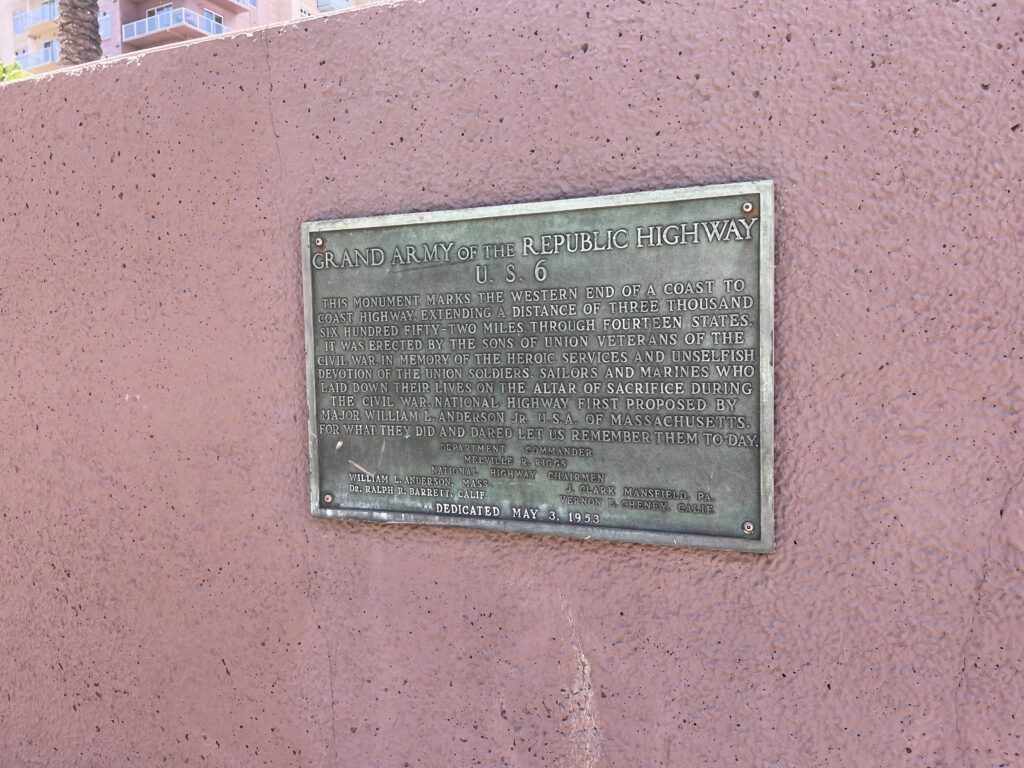
Route 6 spanned 3,662 miles and crossed 14 states. Route 6 was designated in 1927 and initially only spanned 700 miles from Provincetown, Massachusetts to Erie, Pennsylvania. Subsequent expansions to the route led to Route 6 becoming a transcontinental highway when it was expanded to Long Beach in 1937.
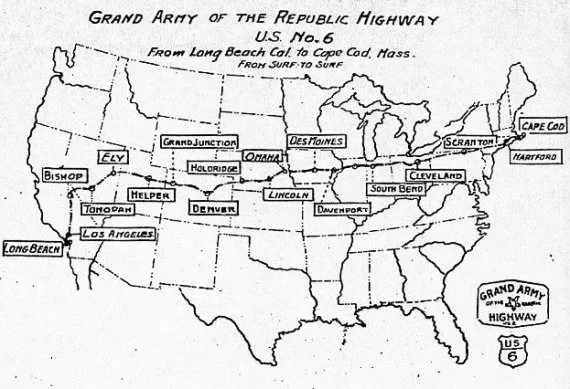
Photo Credit: Sons of Union Veterans of the Civil War Department of Iowa
In 1937, the organization The Sons of Union Veterans of the Civil War successfully lobbied the state of Massachusetts to designate their portion of Route 6 as The Grand Army of the Republic Highway to honor the Union Forces during the Civil War. They successfully lobbied all the states along the Route, with California adopting the name in 1943 and the last segment in Pennsylvania being adopted in 1948.
In 1953 a formal dedication of the highway took place in Long Beach, with 5 related organizations, including the Sons of Union Veterans of the Civil War and Daughters of Union Veterans of the Civil War. The monument was placed in front of the Municipal Auditorium, marking the end of Route 6.

from The Long Beach Press-Telegram May 4, 1933.
In 1965, the State of California requested that Route 6 end in Bishop, so Route 6 lost its transcontinental status. Portions of the old Route 6 still remain as signed highways including the 110, the 5, and the 14.
Very little remains of Route 6 in Long Beach. The original monument had to be moved when the Municipal Auditorium was demolished in 1975 and the plaque that was on the monument was installed on the wall in front of The Terrace Theater.
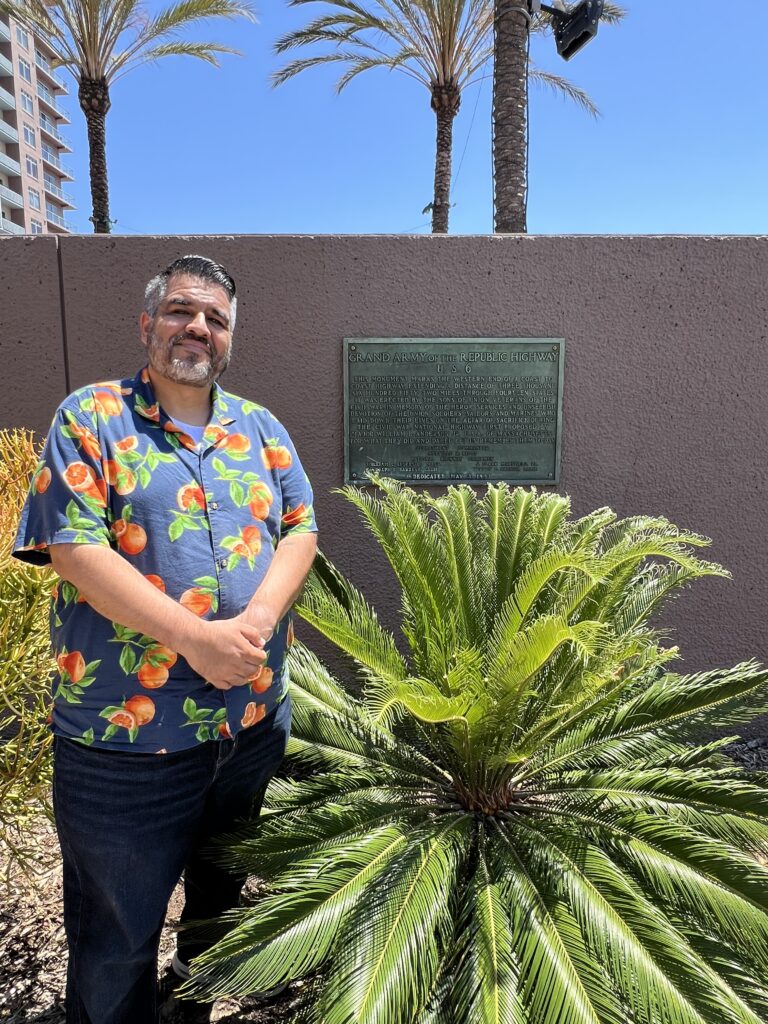
This little bit of history is definitely hidden, but worth checking out the next time you’re in downtown Long Beach.
The last stop was at the Willmore Heritage Garden in front of two pillars that make up the archway to the garden. The two pillars used to be on top of a building on Ocean Blvd known as the Jergins Trust Building. And the Jergins Trust Building used to have a tunnel that went underneath that building and led to the beach.

The Jergins Building was located in downtown Long Beach at the corner of Ocean Blvd and Pine Ave. The building was built in 1919 and known as the Markwell Building, it was 6 stories high and included a theater where Fred Astaire once performed. The building was purchased a few years later by the Jergins Oil Company, who added additional floors and an underground arcade to the building.

Photo Credit: W. Mahan & Joseph J. Musil Photo Theatre Collection.
In 1927 city councilman Alexander Beck led an effort to build a tunnel underneath Ocean Boulevard through the Jergins Arcade and connect it to the beach. So why build a tunnel, couldn’t people just cross street? Well, Ocean Boulevard was much narrower back then with cars and trains running up and down the boulevard. On busy weekends, up to 3,000 people an hour were crossing Ocean Blvd to get to the beach and to The Pike Amusement Park. Mix all those pedestrians and traffic and it was a sure recipe for disaster. So, the Jergins Tunnel was opened in 1928 to allow pedestrians to safely make their way to the beach without having to play Frogger.

Photo Credit: The Historical Society of Long Beach.
.The 181-foot tunnel Art Deco tunnel had a vaulted ceiling with a skylight and beautifully ornate tiles along the walls and floor. The tunnel was also full of vendors, selling you all kinds of things from shoeshines and soap carvings to pottery and even bathing suits, you know, in case you forgot yours.
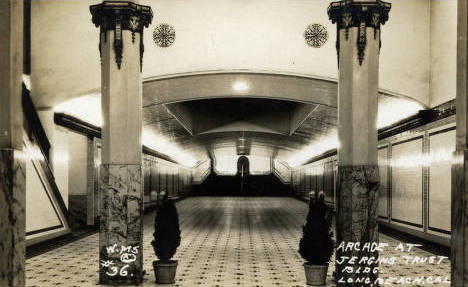
Photo Credit: Long Beach Public Library.
The tunnel remained opened until 1964 when the city decided that it needed to widen Ocean Blvd. Then in 1988, the Jergins Building was demolished. However, not all of it was lost, apart from the two pillars that were saved and used to make the archway to the Willmore Heritage Garden, there are still remnants of the building and tunnel on Ocean Blvd.
You can still see the driveway that was in front of the building, as well as some pillars along the sidewalk . And the tunnel is still there, it’s just closed off to the public.
The Tunnel recently gained new attention thanks to Lana del Rey’s album “Did You Know There’s a Tunnel Under Ocean Blvd” which Jesse may or may not have been responsible for.
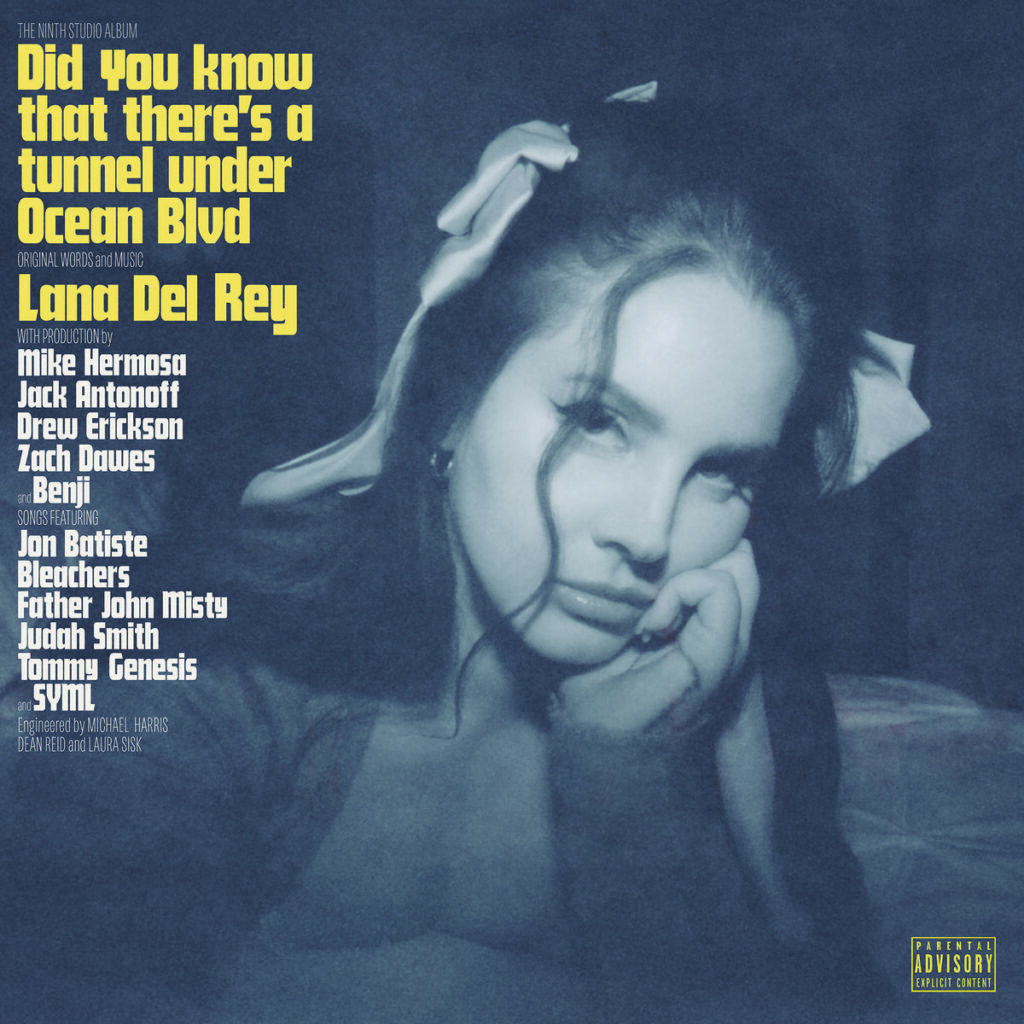
There is a plan to preserve and reactivate the Jergins Tunnel by turning it into a speakeasy as part of the Hard Rock Hotel project that’s going up on the former site of the Jergins Building, so we’ll all once again have access to the history and beautiful architecture of the Jergins Tunnel.
References:
“City Invests $3,000,000 in the Aud. and Pier” by Staf, The Long Beach Sun. March 5, 1932.
“Mural for Front of Auditorium is Council Proposal” by Staff, The Long Beach Sun. June 27, 1936.
“Auditorium’s Tile Mural to be Dedicated” by Staff, The Long Beach Sun. Jan. 24, 1938.
“Unique Mural to be Preserved” by Staff, The Long Bech Independent. Sept. 6, 1972.
“Mural Moves with the Times” by Elise Emery, The Long Beach Independent, March 21, 1975.
West Coast Theater | Los Angeles Theaters Blog
Fox West Coast Theatre | Cinema Treasures
“Long Beach West Coast Theater’s Hidden Statue” by Hey Long Beach YouTube Channel. May 26, 2024.
“GAR Memory Perpetuated as Five Family Organizations Open Parley” by Don Brackenbury, The Long Beach Press-Telegram. May 4, 1953.
“Grand Army of Republic Regains Spot in History” by Hugo Martin, The L.A. Times. Nov. 5, 1992.
“U.S. 6 – The Grand Army of the Republic Highway” by Richard F. Weingroff. Federal Highway Administration.
“Long Beach History: Route 6” by LBTV YouTube Channel. Feb. 1, 2023.
“Attractive Passage Under Busy Street is Big Traffic Aid” by Staff, The Long Beach Sun. March 31, 1929.
“Hard Rock Hotel Plans 2027 Opening in Long Beach; Jergins Tunnel to be Speakeasy, Mayor Says” by Brandon Richardson, The Long Beach Business Journal. Nov. 13, 2023.
“Long Beach Lost: With Hard Rock Hotel going on Top of Jergins Tunnel, a Look into the Past” by Brian Addison, longbeachize. Nov. 14, 2023.

